Sometimes, you may find yourself in an odd situation when you have internet but your friend doesn’t. You then go to text them and realize you’ve already reached your plan limit. What do you do now? Or, maybe you have to text a reminder to company employees but it’s too tedious to type the message on your phone. For both occasions, sending emails to text messages would be ideal. Your friend would receive your message through text, and you can send a group email as bulk SMS to your employees.
In this article, we’ll guide you through sending emails to text messages, its limitations, and the pros and cons of this method. We’ll also explain the difference between SMS and MMS, as well as ways to know the network gateway domain of your message recipient.
Also read: The Best Email Apps on Mobile
Can You Use an Email to Text Someone?

Since we already mentioned we’d guide you through how to use an email to text someone, the answer is yes! Sending an email as a text message is as simple as making any normal email. Although, there are a few hurdles you’d have to jump through though. These have to do with character limits, ASCII character coding, network gateway domains, and how phone carriers handle their email to text feature.
MMS vs SMS: Their Implications When Texting from an Email
First off, what’s the difference between Multimedia Messaging Services (MMS) and Short Message Services (SMS)? Below is a simplified explanation for both.
SMS is used as a communication standard protocol between devices. This format is an evolution of earlier technology like those used in pagers, beepers, and Telex machines. The first SMS in 1992 had the standard 160 American Standard Code for Information Exchange (ASCII) character limit still in use today.
MMS, meanwhile, is a newer technology that extends the functionality of simple SMS. The first MMS-capable phone was released in 2002 and only gained popularity from 2004 to 2005 in the US. Also called PXT or picture messaging, MMS allows messages of more than 160 characters. The biggest draw of MMS compared with SMS is its feature that allows users to send media to each other aside from just text. You can send photographs, short videos, or even audio files.
Now, we’ve explained what MMS and SMS are so you may be wondering why it’s important to know what these two are. When you send an email to a phone number, that email gets converted either to MMS or SMS when it reaches the recipient. That means the limitations of both protocols are enforced on the received message.
Sent emails comprising only of ASCII below the 160-character limit would be sent as SMS. Meanwhile, those that do go over or email with photographs, video, and the like would be turned into MMS instead. Some carriers do not convert emails with more than 160 characters into MMS. Instead, they send them as two or more SMS messages.
How to Convert Emails to Text Messages
Composing your messages is easy. The problem now comes in what address to place into recipient box. Since phone numbers aren’t email addresses, you’ll have to use “Network Gateway Domains” instead. These domains are controlled by phone carriers and are responsible for “converting” your emails.
What Are Network Gateway Domains?
Generally, carriers have their own separate SMS and MMS gateway domains. These domains are usually listed in that carriers’ help sections or could be asked from customer support. Below is a list of most major carriers and their SMS and MMS domains.
| Network | SMS Gateway | MMS Gateway |
|---|---|---|
| AT&T | txt.att.net | mms.att.net |
| T-Mobile | tmomail.net | tmomail.net |
| Verizon | vtext.com | vzwpix.com |
| US Cellular | email.uscc.net | mms.uscc.net |
| Sprint | messaging.sprintpcs.com | pm.sprint.com |
| Google Fi | msg.fi.google.com | msg.fi.google.com |
| Cricket Wireless | mms.cricketwireless.net | mms.cricketwireless.net |
| Virgin Mobile | vmobl.com | vmpix.com |
| Straight Talk | vtext.com | mypixmessages.com |
| Cricket Wireless | mms.cricketwireless.net | mms.cricketwireless.net |
| Boost Mobile | sms.myboostmobile.com | myboostmobile.com |
| FirstNet | txt.att.net | mms.att.net |
| MetroPCS | mymetropcs.com | mymetropcs.com |
The domain list we’ve presented here isn’t as extensive due to mobile virtual network operators (MVNO) who sometimes have subscribers with differing carrier gateway domains like TracFone and Republic Wireless. If your carrier isn’t on the list, we suggest using the Free Carrier Lookup Service which will give you both SMS and MMS domain gateways for that number.
You should also keep in mind that some networks only offer MMS services depending on the recipient’s messaging service plan. This means that recipients of the email to MMS messages may be faced with additional charges to view their mail.
How to Send Text From Email?
Now comes the important part, how you’ll send your messages. As explained earlier, sending an email as a text message is the same as any other email you’d make. You first go onto your email client (Gmail, Yahoo! Mail, Thunderbird, Outlook, etc) and compose your message. Even with all the different domains, you can follow these steps to know the “address” you should send your email to:
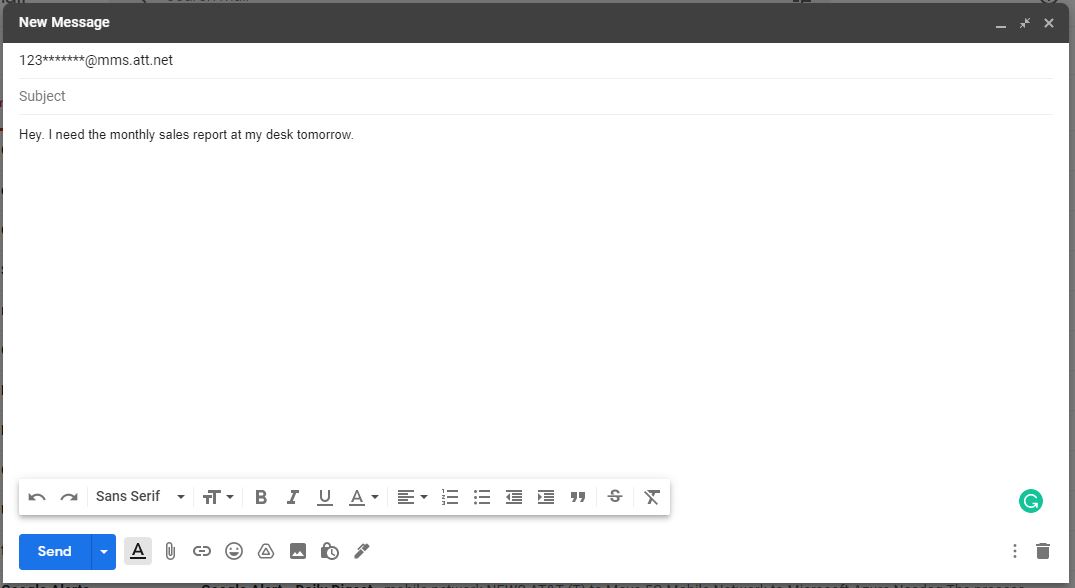
1. Determine whether your email needs an SMS or MMS gateway.
2. Select the gateway and add an “@” at the start of it.
3. Add the 10-digit mobile number of the person you’re sending your message to before the “@”. For 11-digit numbers, you can remove the “+1” at the start. That’s the country code for the US and Canada and is only used for international connections.
4. If it’s an A&T subscriber, your “email” recipient should look something like “123*******@mms.att.net”. “Emails” of other carriers should look similar.
Sending Email Through Extensions and Other Applications
There are a few ways to enhance your email to text experience. This would range from browser extensions that add functionality to your email clients to web app services, commercial SMS network gateways, and business communication services.
Browser Extensions
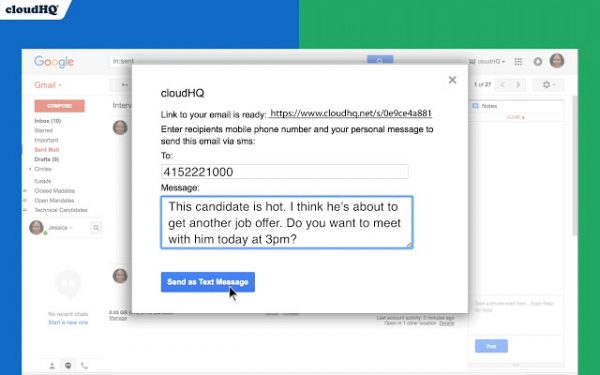
Browser extensions are “applets” that give more functionality to browsers like Google Chrome and Mozilla Firefox. A good example of a browser extension is “Send Your Email to SMS.” It is a Google Chrome extension that erases some of the hassles when sending email to text when you’re using Gmail. The extension does this by embedding itself onto your Gmail interface and saves you the need to find the network gateway domain. It requires you to just input the recipients’ mobile number and hit send instead.
Network Gateways
You could also buy a commercial SMS or MMS network gateway. These are privately owned gateways that have the same features as carrier gateways. You’ll find that most offer bulk SMS or MMS messaging, two-way messaging, and proprietary programs to access them. These services are usually bundled as a business communication suite and aimed at businesses. Business suites handle most communication requirements a business might need. This ranges from automatic call answering, email to SMS clients, and payment collection.
Also read: How to Block Text Messages on Android Devices
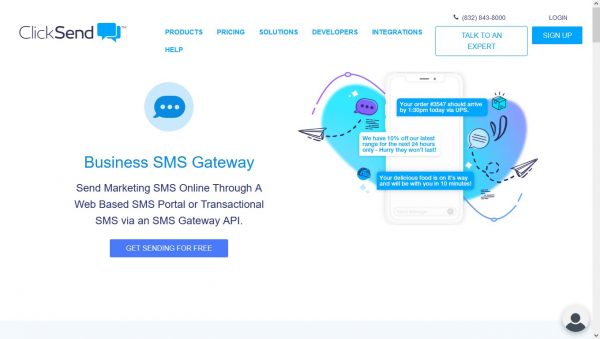
An example of these services is ClickSend. Their “Business SMS Gateway” has an international Online SMS Gateway with an API, an Email to SMS service, compatibility with Microsoft Outlook, and an SMS Aggregator.

SMSGlobal is another example that works with Gmail and Microsoft Outlook. They have an applet similar to “Send Your Email to SMS” that adds SMS functionality to Microsoft Outlook and Gmail. Aside from that, they also have a business communication suite with services like ClickSend.
Web App Service
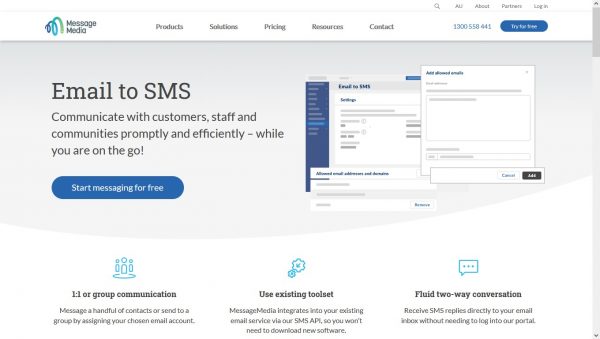
A different option would be to sign up for a web app service. These services are usually a part of a comprehensive business communication suite. There are some like Message Media that have a separate email service as well.
Things to Remember When Sending Emails to Text
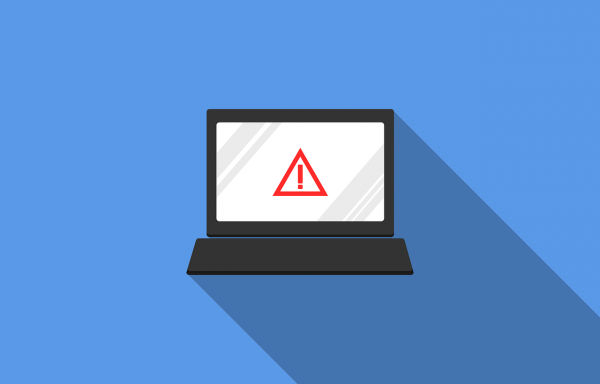
Now that we’ve given to you the know-how to send your emails to a mobile number as text messages, there are just a few things you should keep in mind when using these services.
1. All SMS and MMS messages received from emails would register “sender” cellphone numbers with mobile numbers starting with “10101.”
2. Since it’s being sent as an SMS or MMS, the same problems would be encountered. Things like bad signal reception, slow transmission times, and other issues would not guarantee your “email” was properly sent.
3. Remember that SMS and MMS messages only accept standard US-ASCII characters. This means that letters and characters sent in another language like Cyrillic or Korean would be read as gibberish to the recipient. Most characters on US-QWERTY keyboards are accepted US-ASCII characters.
4. SMS messages only have 160 characters and those going over the limit would be sent as multiple SMS messages.
5. Carriers and MVNOs are incentivized to limit communication like this. This is due to the service essentially being “free” texting. They may throttle your data or block the sending of your messages entirely.
Other Methods of Sending Text Messages
Hopefully, this guide has helped you send your email to text and explained its pros and cons. Maybe you’ve also texted that friend and he’d replied. In any case, knowing this would help when you’ve run out of text credits or when you’re in an emergency.
Aside from Email to text messages, there are other ways for you to send a message to a mobile number. These ways include using the iMessage on Mac systems, Android Messages on Windows and Linux, and the Your Phone Companion app on Windows 10. We’ve made an article on the best ways to send a text from a computer that you can read up on.
If you’re looking to have similar features like calling a landline or cellphone number through your computer’s internet, you might like to read through our article on the best virtual phone numbers.
